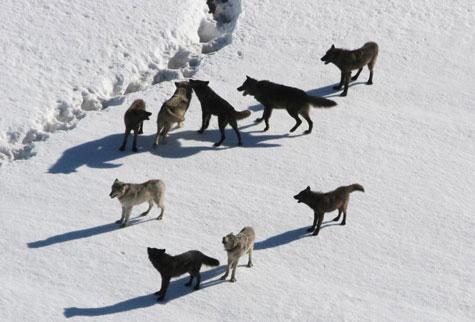Yellowstone National Park has released its annual Wolf Report, which describes the status of wolves in the park. According to the report, the overall wolf population in the park is up slightly from 2012, similar to previous recent years, and down about 45 percent since 2003.
Here's the key information from the report's Executive Summary:
There were at least 95 wolves in 10 packs and one group (8 breeding pairs) living primarily in Yellowstone National Park during December 2013. These totals are slightly higher than reported in 2012, but similar to previous years when about 100 wolves were counted.
Wolf numbers have decreased by about 45% since 2003 when the population estimate was 172. This is likely due to fewer elk in the ecosystem. Wolf numbers decreased less in the interior of the park than in northern Yellowstone, likely due to supplemental feeding on bison by those packs.
State-managed wolf hunts during 2013 did not significantly affect wolves primarily living in the park and the occurrence of mange continued to decrease in 2013. There was no evidence of distemper being a mortality factor as compared with previous years. Pack size ranged from 2 to 18 and averaged 8.6 wolves.
Nine of 10 packs, plus one lone female, had pups. The average number of pups was 4.6, which is higher than the previous two years. At least 41 pups survived to the end of the year.
Project staff detected 269 kills that were definitely, probably, or possibly made by wolves during 2013, including 193 elk (72%), 16 bison (6%), 13 mule deer (5%), and low occurrences of other or unidentified species. The composition of elk kills was dominated by calves and yearlings (43%), followed by cows (33%) and bulls (14%). Some kills could not be identified to age or sex. Bison kills included nine calves, two yearlings, two cows, two bulls, and one adult of unknown sex.
Other research involving wolves during 2013 included population genetics, population regulation, disease, hunting behavior, spatial analyses of territory use, pack leadership, multi-carnivore-scavenger interactions, breeding behavior, dispersal, and observations of wolf, grizzly bear, and bison interactions in Pelican Valley.
Nine wolves in four packs were fitted with radio collars during February and early March. Seven wolves in three packs were radio-collared during December. At year's end, 24% (21 wolves) of the wolf population was collared.
Wolf management activities included den site closures and several hazing events. Staff continued to manage wolf viewing areas in Slough Creek, the Lamar Valley, and other hot spots where wolves were frequently sighted. Public outreach included giving 265 formal talks, participating in 82 interviews, helping 18,000 people view wolves, making 18,822 visitor contacts, and giving hundreds of informal talks in the field.
You can download a copy of the 2013 Wolf Report here, and you'll find additional information about wolf management in the park at this link.




Add comment